A Classic French Recipe for Chicken Fricassee
When you think of Coq au Vin, do you think “This must be a difficult French dish to prepare?” If you do, you are making a big mistake. This dish is simple to prepare and very economical.
In years past, the farmer would make this meal with an old unproductive rooster. Today you can’t find a rooster in the supermarket, young, old, or unproductive. Instead, we might try substituting dark meat chicken.
Coq au vin is much more about technique than it is about a recipe. While endless variations are possible, this one is very tasty.
Although as written, this is a two-day process, it is not imperative to refrigerate overnight if you really want to eat it the same day you make it.
How to Make Coq au Vin at Home
If someone asked you to name just one classic French recipe, I wonder how many of you would say Coq au Vin. You see it on the menu for most “authentic” French restaurants, and they most likely charge a pretty penny for a dish that is basically mature chicken braised in wine.
In fact, Coq au Vin translates to “rooster in wine” and is a very basic dish that was prepared in most French farmers’ kitchens.
I thought looking at this classic dish from a home cook’s perspective would be interesting. I wanted to know more about how this dish came about and why these French farmers used an old rooster to cook with.
Why do many home cooks think this is a difficult dish to prepare besides not being able to find an old rooster?
This post will look at some of the early history of Coq au Vin, how it was prepared years ago, and how we can make it today. It is not so much of a recipe but a cooking technique that can be used to prepare many dishes once learned.
You will see legendary cook Julia Child’s recipe for Coq au Vin and a video of Chef Alton Brown preparing it on TV. There are some polls and a place where you can make comments about anything and everything “coq au vin”
What Is Coq au Vin?
Coq au Vin is one of those dishes that sounds very upper-crust and snobbish, but this dish was conceived on humble peasant farms, not in the palaces of the wealthy. Coq au vin is French for “rooster in wine.”
When a rooster got too old to be useful on a farm (read: he could no longer impregnate the hens), the farmer wouldn’t just keep him as a pet. That would have been considered a waste of a perfectly good rooster!
So what the farmer’s wife would do would be to kill the rooster and cook it. The problem is that an old rooster is tough, and his meat is full of connective tissue from years of strutting around the barnyard.
To make this tough old bird edible, she cooked it at a low temperature and covered it with wine. Coq au vin is a braise or a stew.
And through braising, that French farmer’s wife was able to make something truly tasty out of nothing but a tough old rooster and a bottle of cheap wine.
As with most peasant foods, it was based on the necessity of not wasting anything – of making something tough and inedible tender and tasty through the use of moist heat cooking methods. It is highly unlikely that the French upper class ever ate coq au vin. They never needed to, as they could always afford more tender meat.
A Little Coq au Vin History
One of the earliest written references to coq au vin comes from L’Art de Bien Manger, or The Art of Good Eating, by Edmond Richardin in 1938. This seems quite a modern reference, but it is certain that this type of dish was passed down from mother to daughter for centuries in countless farmhouses all across France. As such, coq au vin isn’t so much a recipe as it is a technique.
I’m guessing although it may not have been called Coq Au Vin, as soon as someone threw an old worn-out hen or rooster into a pot with a whole lot of wine and slow-cooked it over a fire, we had the beginnings of this classic dish.
According to my friend Peter Hertzmann,
“Coq au vin falls into the general classification in French cooking of a fricassée, which is a form of braising. So the concept is very old. I’m sure if I looked through Apicius, I’d find that the Romans cooked chicken in wine.
The first time the term coq au vin appeared in print is 1913, and the first printed recipes with the name were a decade later. The rooster appears even later, probably introduced by someone who didn’t know the recipe’s origins.”
According to The Oxford Companion to Food
Although Coq au vin is well known and was featured on numerous menus in the third quarter of the 20th century, it does not have a long history. The flesh of a cock has always been regarded as somewhat tough and indigestible, and with few exceptions cooks of earlier centuries saw no merit in cocks except as a source of cockscombs (much in demand as a garnish) and sometimes for making a bouillon.
One of the very first recipes for Coq au vin, that of Brisson published in Richardin’s L’Art du bien manger [a periodical] (1913), was presented as a real ‘discovery’, the author having been surprised to find the dish in Puy-de-Dôme, and surprised by how good it was.
The ingredients in this case were the cock, good wine of Auvergne, bacon, onion, garlic, and mushrooms. Wine from Burgundy has since become the one commonly used, and indeed many recipes say ‘red wine’.
The upsurge of interest in regional cuisines has recently brought other similar traditions for preparing Coq au vin to light. In Franche-Comté the bird is simmered in vin jaune; and in Alsace in Riesling. ln both these regions morels and cream are gladly added if available.
Indeed, knowledgeable food experts no longer speak of Coq au vin in the singular but of coqs au vin in the plural while acknowledging that these dishes were doubtless simmering away for long years before the first recipes were published and before the gastronomes ‘discovered’ the virtues of simple country fare.
But Where Do I Find An Old Rooster You Ask
You Don’t and Wouldn’t Want To
These days, especially here in America, home to large-scale, industrialized farming, it is very difficult, if not impossible, to find an “old rooster” that needs tenderizing. Unless you own your own chickens, finding a chicken older than 6 months is probably almost impossible. There are two ways around this problem:
- We can be very happy that we don’t have to eat tough old roosters, or
- We can substitute other meat for the rooster.
Since we are looking for as much connective tissue as possible to enrich the eventual sauce, I suggest using dark meat chicken quarters if you can find them. If not, using any combination of thighs and/or legs will produce good results.
Now that we have the rooster stand-in figured out, we need to look at how to prepare him. First, consider how we want the dish to taste and feel in our mouths.
The meat should be tender. The sauce should be somewhat thickened and well-seasoned. It’d be nice to have some crunchy bits to contrast with the silky sauce and tender meat.
Tips For Great Homemade Coq au Vin
- How do you get the meat to be tender? – Braise it in wine.
- How do we get the sauce to be a little thick? – Use a roux.
- How do we make sure the sauce is very flavorful? – Mire poix and a bouquet garnis.
- How can we add some crunchy bits? – Bacon!
Now knowing all of that, let’s review techniques.
- To braise, we’ll want to brown our meat. We need some fat for that. We might as well use the bacon fat, so we’ll want to cook our bacon first.
- After we brown the bird, we’ll build our roux, adding flour to the pot equal to the amount of fat in the pan. If there isn’t an ounce or so of fat in the pan, we’ll add a little more.
- We’ll chop our onions, celery, and carrot for our mirepoix and tie together a couple of garlic cloves, a bay leaf, a sprig or two of thyme and parsley, and a couple of peppercorns to let it steep during the braising process.
And that is how you make coq au vin!
Coq au Vin Recipe
Ingredients
- 3 ounces bacon thick-cut, cut cross-wise into ½ inch pieces
- butter or neutral oil, as needed
- 3 dark meat quarters or thighs and legs to fit in one layer in the bottom of a Dutch Oven
- 1½ ounces all purpose flour
- salt and black pepper to taste
- 2 medium carrots cut in small dice
- 2 medium celery stalks cut in small dice
- 1 medium-large onion cut in small dice
- 2 tablespoons tomato paste
- 1 bottle dry red wine
- chicken stock homemade or low-sodium canned, as needed
- 8 ounces peeled pearl onions whole
- 8 ounces button mushrooms small ones cut in half, large ones cut in quarters
For the Bouquet Garni
- 2 bay leaves
- 2 sprigs fresh thyme or ½ teaspoon dried
- 2 sprigs fresh parsley or 1 teaspoon dried
- 3 cloves garlic
- 5 pepper corns
Instructions
- In the bottom of a large Dutch oven, fry bacon pieces until crisp. Drain and reserve bacon. You should have 1 - 2 tablespoons of bacon grease in the pan's bottom. If not, add a little butter or neutral vegetable oil.
- You can remove the skin from the chicken pieces depending on how much fat you like. Sear chicken pieces on all sides until golden brown. Reserve.
- Again, add butter or oil to have 1 - 2 tablespoons of fat in the pan. Sauté the peeled pearl onions with salt and pepper until golden brown. Reserve. If necessary, add more oil or butter to the pan, and sauté the mushroom pieces with a pinch of salt and pepper until golden brown. Reserve.
- Add the carrot, celery, onion, and a pinch of salt and pepper, and cook over medium heat until the vegetables soften and turn golden.
- Add the flour, whisk, and cook over medium heat for 1-2 minutes. Add the tomato paste and cook another minute or two. Deglaze the hot pan with a cup or so of wine.
- Put the chicken back into the pan. Add the rest of the wine. Cover the pot and refrigerate overnight.
- The next day, preheat the oven to 300°F, and add enough chicken stock to the pot to almost cover the chicken.
- Tie the bay leaves, thyme, parsley, garlic cloves, and peppercorns together in a square of cheesecloth and add to the pot. Submerge the bouquet garni in the cooking liquid.
- Cover the pot tightly and let braise in the oven until the chicken is very tender about 3 hours.
- Remove the chicken and the bouquet garni from the pot at the end of the cooking time. Reserve the chicken and keep it warm. Throw the bouquet garni away. Do not get the two confused and throw away the chicken.
- With an immersion blender, blend the sauce until smooth, and then reduce on the stovetop by about ¼ or until a nice saucy consistency.
- Taste the sauce and add more salt and/or pepper, if needed.
- Add back the reserved onions and mushrooms and heat through. Add the chicken back to the pan and stir everything together.
- Heat the bacon pieces on a baking sheet in the oven.
- Garnish each serving with some of the hot, crispy bacon pieces.
What wine goes great with coq au vin?
A red Burgundy from France or possibly a Petit Sirah.

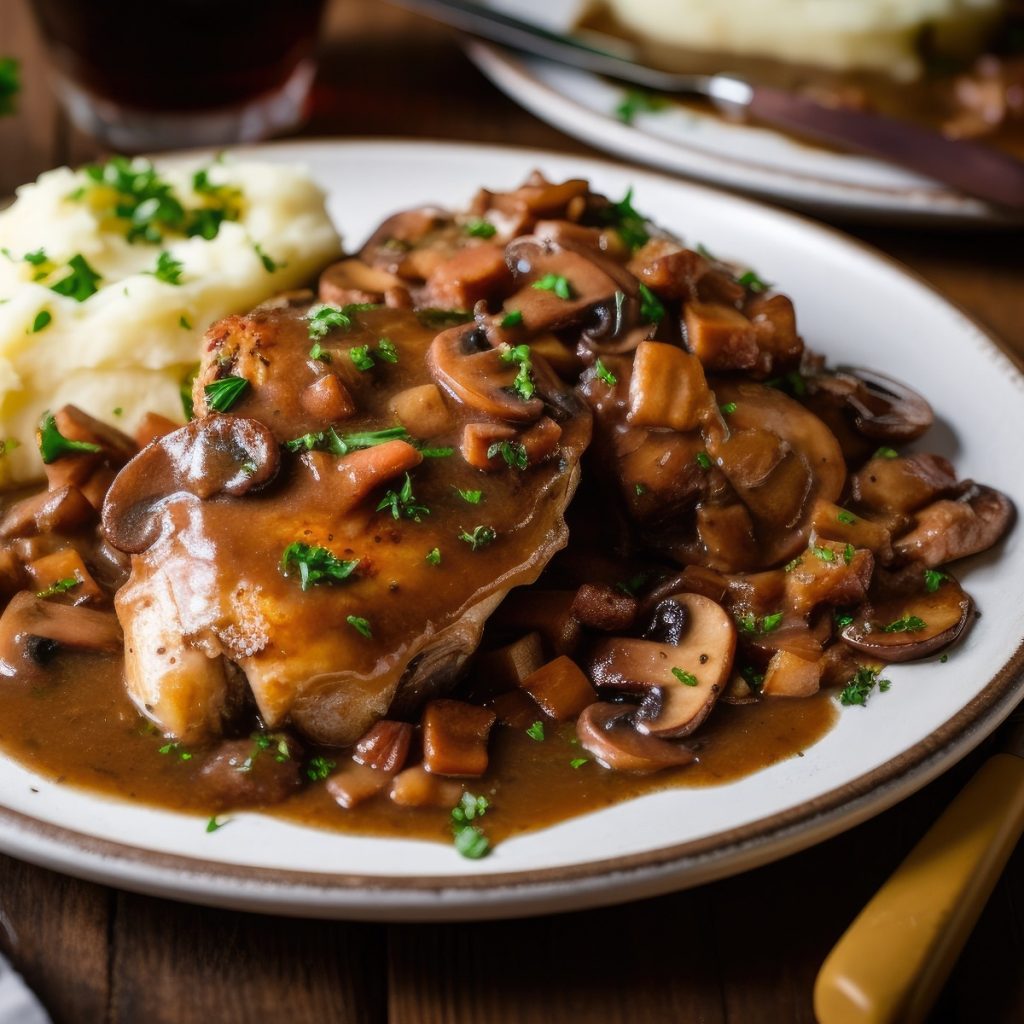

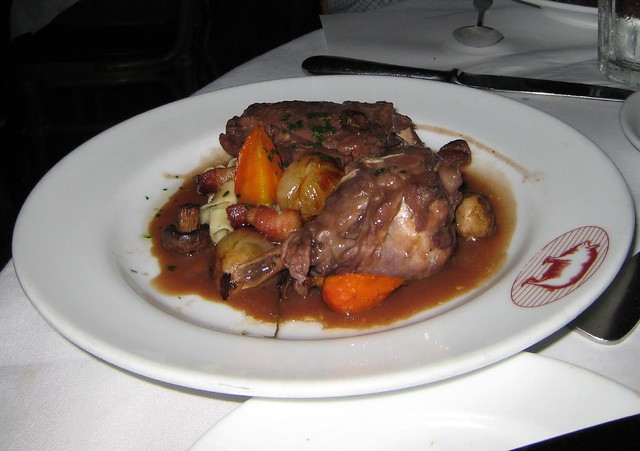
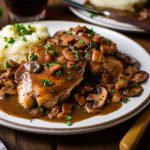
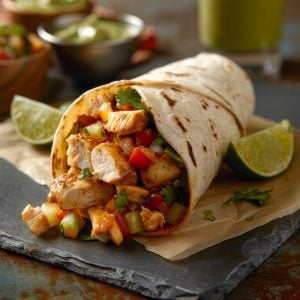

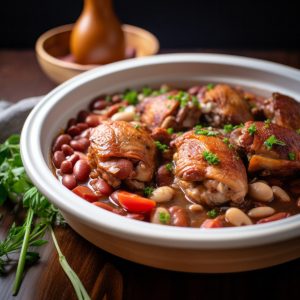
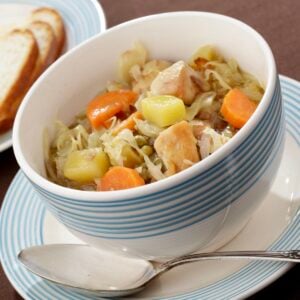
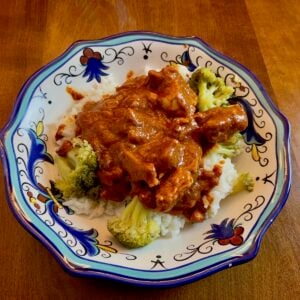
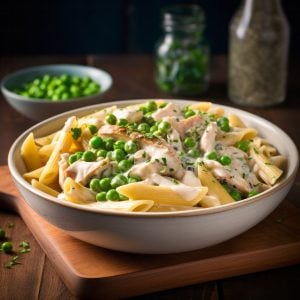
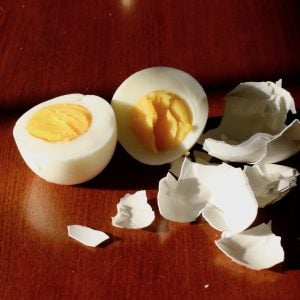
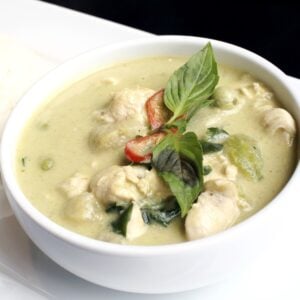


5 Responses
RG: You must dig deeper into coq au vin history. The dish is less than 100 years old and was not prepared initially with a rooster or an old hen. That interpretation probably came about from a cook not knowing the origins. The name was just meant to be colorful.
Hi Peter, I read your article on coq au vin and found it very interesting and very informative. Thank you for bringing it to my attention however I’m still a little confused as why you don’t think the dish was around more than 100 years. You bring up a good point though, is a recipe officially a “recipe” only after it is published in a cookbook? For example, if farmers were stewing their old roosters in wine for hundreds of years, is it only Coq au Vin after it is published?
I think this debate is a debate of semantics. Recipe versus technique. There is no doubt in my mind that folks have been tenderizing tough birds in wine for hundreds of years.
Culinary history is very murky, at best, and I really think it might be good for the “sport” and less intimidating for novices if we all just relaxed a little.
A recipe is like a snapshot–a portrait of one moment in time. Just as the girl in the picture existed before the picture was taken and will continue to live afterwards, surely dishes have been made to one standard or another both before and after the publishing of a particular recipe–one cook’s way of doing something on that particular day.
Good points, especially how a “recipe is like a snapshot…of one moment in time”.
Here’s this farmer to settle your curiousities surrounding Coq au Vin. There were no designation as to age of the chicken in a number of the recipes because in 1913, they were ALL old! and, lurking around the time of WWI and II… was a shortage of food which produced the need make what they had edible! Why were they all old?
Chickens work like this— a graph moving left to right, vertical axis is age, horizontal axis is tenderness/flavor . Lower left corner is day one, just born. As we move to the right with every day, so we must move up the flavor and tenderness chart. The older a chicken gets, the more flavor it has, but the tougher the meat is. Modern chickens are genetically engineered to grow abnormally large breasts AND to do it in record time, 6 weeks. (A 6 week old chicken is as tender as it gets, though has comparitively little flavor.) Before these chickens and high protein ‘pushing’ of food on them, were ‘invented’, they were regular chickens that took 14 weeks to amount to any size at all, before 14 weeks the chickens were little bigger than a pigeon! So, there you have it— most All chickens big enough to eat were tough, so no need to specify a rooster to hold up to the long hours of boiling!
Very interesting Cissy. Thanks for sharing that information with me. – RG